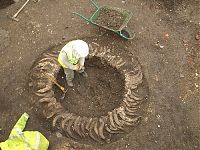What is environmental evidence?
On a dig, the larger pieces of what is called ‘environmental evidence’ are easily spotted and collected. This could be bones, shell, large seeds or waterlogged wood. Not everything from the past will survive after it has been buried. The type of soil and the nature of the site will affect what remains will be found.
But what about the smaller pieces? If archaeologists only collect what they can see, they are missing all the tiny ecofacts that are invisible to the naked eye. As a result, they won’t have all the information available, and the evidence from the site becomes what is known as a ‘biased assemblage’ – in other words, the evidence doesn’t represent a true picture of what happened in the past.
This is where environmental archaeology makes a big difference. If an area of the site is thought to be especially important, further environmental analysis can answer archaeological questions for that area or the site as a whole, when buckets of soil are collected – we call these ‘soil samples’.
These buckets of soil are then put through a machine called a flotation tank. This is a very easy and efficient way of washing the dirt away, leaving behind the larger bits of archaeological and environmental evidence. These are then extracted and are studied along with the larger pieces that were collected by hand.
What can we learn from these environmental remains?
Below are just a few examples of what we can learn from certain types of environmental finds:
Animal Bones
The bones and teeth from large mammals, such as cows, can tell us about the environment, what the human population ate, if they may have wore leather (from cut marks on the bones), what they did for a living, and even their beliefs. The age or sex of the bones can even tell us what the animals were used for. Lots of very young male cows suggest that they came from a dairy herd, as they would have been killed soon after birth to ensure a regular milk supply for human use, while the females would have been kept and milked when they had grown. So we can suggest what other things people may have eaten as well.
Wild animals can tell us about when a site may have been used at what point during the year, the types of weapons that the humans must have made and used in order to catch the animal, as well as what the local environment was like as a whole.
Insects
Insects can tell us about the past environment, past living conditions and hygiene, and what an area of the site was used for. For example, certain types of beetle will live in certain types of habitats such as dung, human excrement or grain. If a building is found that contained large amounts of grain with lots of insect remains then the building may have been used as a grain store.
Plant remains
Plant remains provide evidence on everything from environment, diet and farming practices to the feeding of animals. The location and quantities of plant remains on the site can suggest what an area was used for. Large amounts of grain found in a building would again suggest a grain store, especially if it is coupled with insect evidence.
- By: Lorna Richardson |
- Mar 25, 2008
- Share
